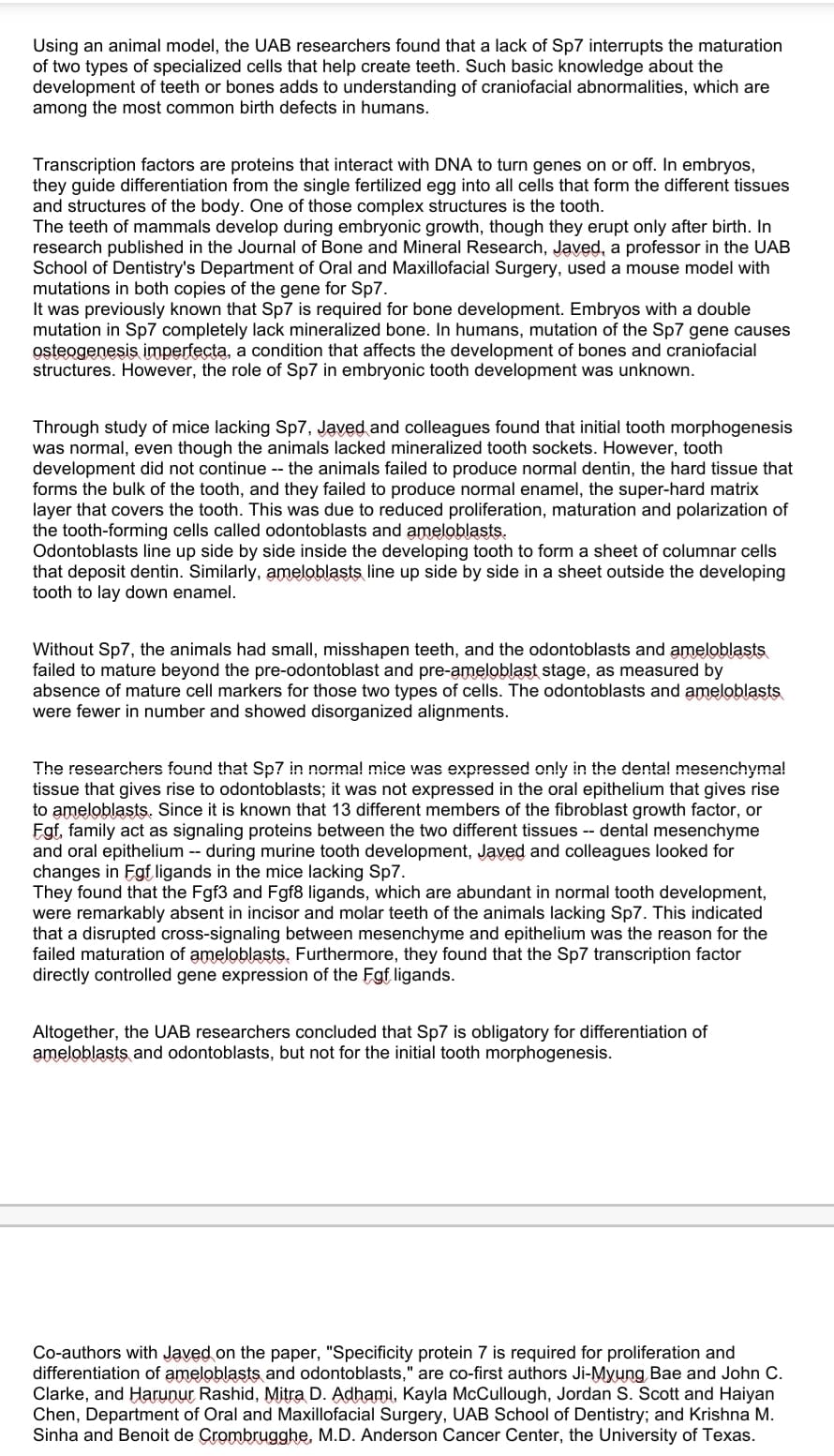Biology (MindTap Course List)
11th Edition
ISBN:9781337392938
Author:Eldra Solomon, Charles Martin, Diana W. Martin, Linda R. Berg
Publisher:Eldra Solomon, Charles Martin, Diana W. Martin, Linda R. Berg
Chapter17: Developmental Genetics
Section: Chapter Questions
Problem 12TYU
Related questions
Question
Briefly summarize the article below

Transcribed Image Text:Using an animal model, the UAB researchers found that a lack of Sp7 interrupts the maturation
of two types of specialized cells that help create teeth. Such basic knowledge about the
development of teeth or bones adds to understanding of craniofacial abnormalities, which are
among the most common birth defects in humans.
Transcription factors are proteins that interact with DNA to turn genes on or off. In embryos,
they guide differentiation from the single fertilized egg into all cells that form the different tissues
and structures of the body. One of those complex structures is the tooth.
The teeth of mammals develop during embryonic growth, though they erupt only after birth. In
research published in the Journal of Bone and Mineral Research, Javed, a professor in the UAB
School of Dentistry's Department of Oral and Maxillofacial Surgery, used a mouse model with
mutations in both copies of the gene for Sp7.
It was previously known that Sp7 is required for bone development. Embryos with a double
mutation in Sp7 completely lack mineralized bone. In humans, mutation of the Sp7 gene causes
osteogenesis imperfecta, a condition that affects the development of bones and craniofacial
structures. However, the role of Sp7 in embryonic tooth development was unknown.
Through study of mice lacking Sp7, Javed and colleagues found that initial tooth morphogenesis
was normal, even though the animals lacked mineralized tooth sockets. However, tooth
development did not continue -- the animals failed to produce normal dentin, the hard tissue that
forms the bulk of the tooth, and they failed to produce normal enamel, the super-hard matrix
layer that covers the tooth. This was due to reduced proliferation, maturation and polarization of
the tooth-forming cells called odontoblasts and ameloblasts.
Odontoblasts line up side by side inside the developing tooth to form a sheet of columnar cells
that deposit dentin. Similarly, ameloblasts line up side by side in a sheet outside the developing
tooth to lay down enamel.
Without Sp7, the animals had small, misshapen teeth, and the odontoblasts and ameloblasts
failed to mature beyond the pre-odontoblast and pre-ameloblast stage, as measured by
absence of mature cell markers for those two types of cells. The odontoblasts and ameloblasts
were fewer in number and showed disorganized alignments.
The researchers found that Sp7 in normal mice was expressed only in the dental mesenchymal
tissue that gives rise to odontoblasts; it was not expressed in the oral epithelium that gives rise
to ameloblasts. Since it is known that 13 different members of the fibroblast growth factor, or
Fgf, family act as signaling proteins between the two different tissues -- dental mesenchyme
and oral epithelium -- during murine tooth development, Javed and colleagues looked for
changes in Fgf ligands in the mice lacking Sp7.
They found that the Fgf3 and Fgf8 ligands, which are abundant in normal tooth development,
were remarkably absent in incisor and molar teeth of the animals lacking Sp7. This indicated
that a disrupted cross-signaling between mesenchyme and epithelium was the reason for the
failed maturation of ameloblasts. Furthermore, they found that the Sp7 transcription factor
directly controlled gene expression of the Fgf ligands.
Altogether, the UAB researchers concluded that Sp7 is obligatory for differentiation of
ameloblasts and odontoblasts, but not for the initial tooth morphogenesis.
Co-authors with Javed on the paper, "Specificity protein 7 is required for proliferation and
differentiation of ameloblasts and odontoblasts," are co-first authors Ji-Myung Bae and John C.
Clarke, and Harunur Rashid, Mitra D. Adhami, Kayla McCullough, Jordan S. Scott and Haiyan
Chen, Department of Oral and Maxillofacial Surgery, UAB School of Dentistry; and Krishna M.
Sinha and Benoit de Crombrugghe, M.D. Anderson Cancer Center, the University of Texas.
Expert Solution
This question has been solved!
Explore an expertly crafted, step-by-step solution for a thorough understanding of key concepts.
This is a popular solution!
Trending now
This is a popular solution!
Step by step
Solved in 2 steps with 1 images

Knowledge Booster
Learn more about
Need a deep-dive on the concept behind this application? Look no further. Learn more about this topic, biology and related others by exploring similar questions and additional content below.Recommended textbooks for you

Biology (MindTap Course List)
Biology
ISBN:
9781337392938
Author:
Eldra Solomon, Charles Martin, Diana W. Martin, Linda R. Berg
Publisher:
Cengage Learning

Human Biology (MindTap Course List)
Biology
ISBN:
9781305112100
Author:
Cecie Starr, Beverly McMillan
Publisher:
Cengage Learning

Biology (MindTap Course List)
Biology
ISBN:
9781337392938
Author:
Eldra Solomon, Charles Martin, Diana W. Martin, Linda R. Berg
Publisher:
Cengage Learning

Human Biology (MindTap Course List)
Biology
ISBN:
9781305112100
Author:
Cecie Starr, Beverly McMillan
Publisher:
Cengage Learning